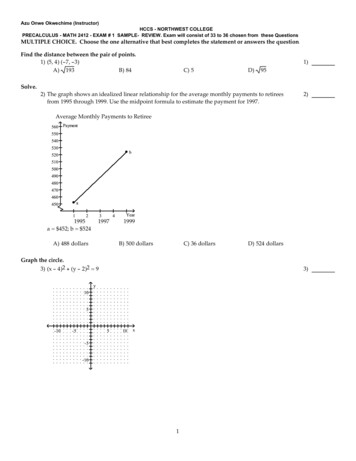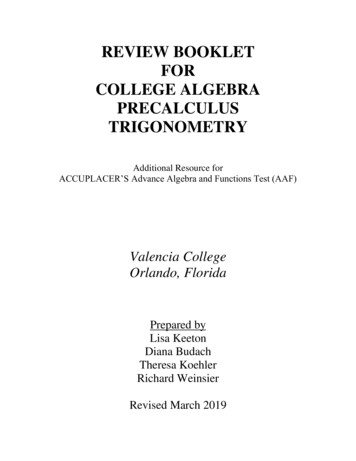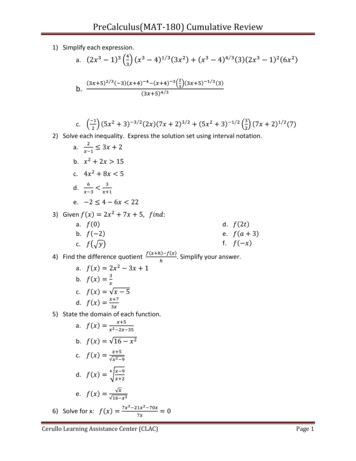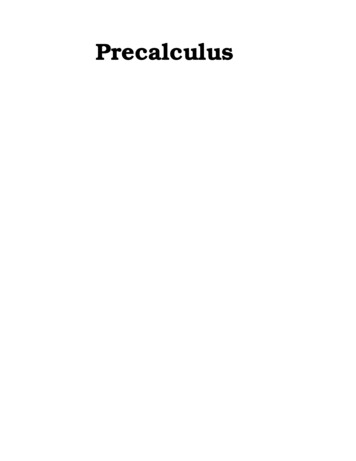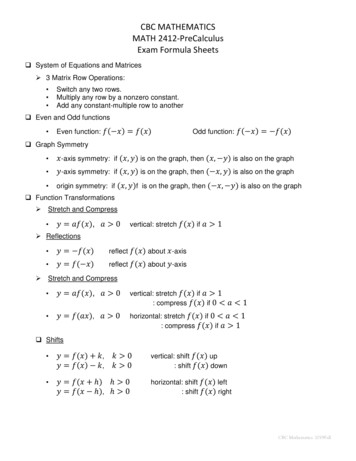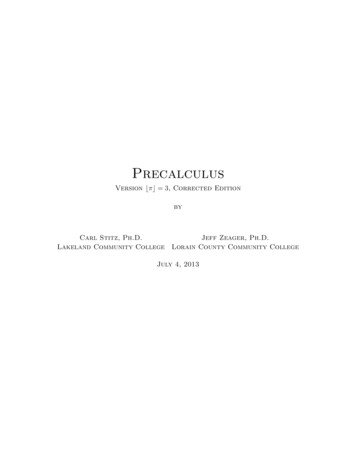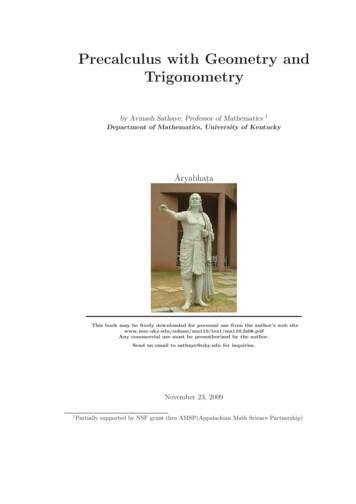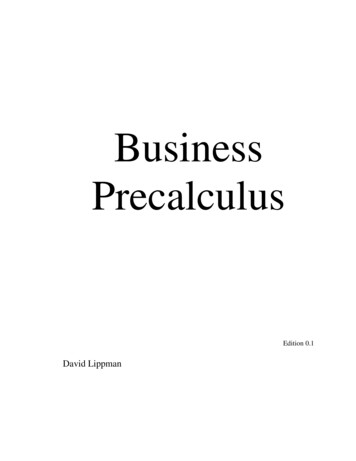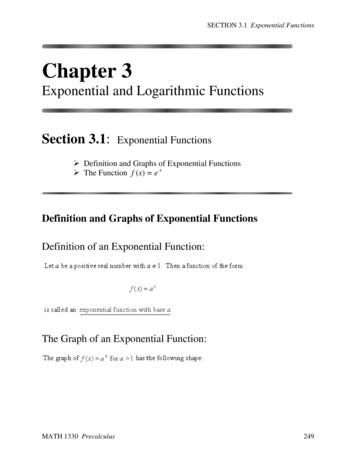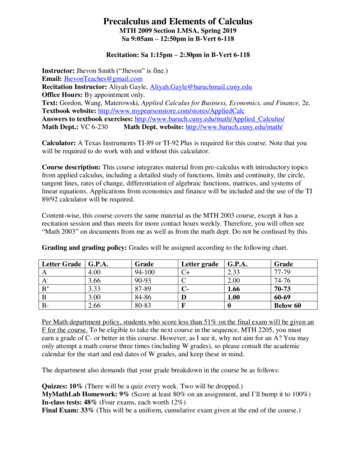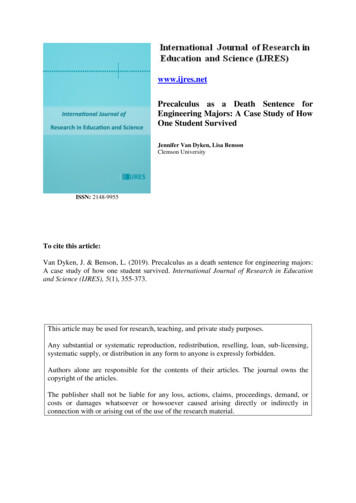
Transcription
C.1Real Numbers and the Real Number Line C1C Precalculus ReviewnC.1 Real Numbers and the Real Number LineDistributioRepresent and classify real numbers.Order real numbers and use inequalities. Find the absolute values of real numbers and find the distance between two realnumbers.Real Numbers and the Real Number LineingorReal numbers can be represented by a coordinate system called the real number lineor x-axis (see Figure C.1). The real number corresponding to a point on the real numberline is the coordinate of the point. As Figure C.1 shows, it is customary to identify thosepoints whose coordinates are integers.opy 4 3 2 10x1234forCThe real number lineFigure C.1 2.6 234.5x012345ge 3 2 154LearningNotThe point on the real number line corresponding to zero is the origin and isd enoted by 0. The positive direction (to the right) is denoted by an arrowhead and isthe direction of increasing values of x. Numbers to the right of the origin are positive.Numbers to the left of the origin are negative. The term nonnegative describes anumber that is either positive or zero. The term nonpositive describes a number that iseither negative or zero.Each point on the real number line corresponds to one and only one real number,and each real number corresponds to one and only one point on the real number line.This type of relationship is called a one-to-one correspondence.Each of the four points in Figure C.2 corresponds to a rational number—onethat can be written as the ratio of two integers. (Note that 4.5 92 and 2.6 135 .)2Rational numbers can be represented either by terminating decimals such as 5 0.4 or1by repeating decimals such as 3 0.333 . . . 0.3.Real numbers that are not rational are irrational. Irrational numbers cannot berepresented as terminating or repeating decimals. In computations, irrational numbersare represented by decimal approximations. Here are three familiar examples. 2 1.414213562e π2π 3.141592654e 2.718281828x0 CengaRational numbersFigure C.2(See Figure C.3.)12Irrational numbersFigure C.334
C2Appendix CPrecalculus ReviewOrder and InequalitiesOne important property of real numbers is that they are ordered. For two real numbersa and b, a is less than b when b a is positive. This order is denoted by the inequalitya b.12a b if and only if a lies to the leftof b.Figure C.4nx0butio 1DistribaThis relationship can also be described by saying that b is greater than a and writingb a. If three real numbers a, b, and c are ordered such that a b and b c, then bis between a and c and a b c.Geometrically, a b if and only if a lies to the left of b on the real number line(see Figure C.4). For example, 1 2 because 1 lies to the left of 2 on the real numberline.Several properties used in working with inequalities are listed below. Similarproperties are obtained when is replaced by and is replaced by . (The symbols and mean less than or equal to and greater than or equal to, respectively.)g b and b c, then a c.Transitive PropertyAdd inequalities. b, then a k b k.Add a constant.in b and c d, then a c b d.opyIf aIf aIf aIf aIf a b and k 0, then ak bk.Multiply by a positive constant. b and k 0, then ak bk.Multiply by a negative constant.forC1.2.3.4.5.orProperties of InequalitiesLet a, b, c, d, and k be real numbers.LearningNotNote that you reverse the inequality when you multiply the inequality by a negativenumber. For example, if x 3, then 4x 12. This also applies to division by anegative number. So, if 2x 4, then x 2.A set is a collection of elements. Two common sets are the set of real numbers andthe set of points on the real number line. Many problems in calculus involve subsetsof one of these two sets. In such cases, it is convenient to use set notation of the form{x: condition on x}, which is read as follows.The set of all x such that a certain condition is true.{ x : condition on x} CengageFor example, you can describe the set of positive real numbers as{ x: x 0 } .Set of positive real numbersSimilarly, you can describe the set of nonnegative real numbers as{ x: x 0 } .Set of nonnegative real numbersThe union of two sets A and B, denoted by A B, is the set of elements that aremembers of A or B or both. The intersection of two sets A and B, denoted by A B,is the set of elements that are members of A and B. Two sets are disjoint when theyhave no elements in common.
C.1C3Real Numbers and the Real Number Line The most commonly used subsets are intervals on the real number line. Forexample, the open interval(a, b) { x: a x b }Open intervalis the set of all real numbers greater than a and less than b, where a and b are theendpoints of the interval. Note that the endpoints are not included in an open interval.Intervals that include their endpoints are closed and are denoted byClosed intervaln[a, b] { x: a x b }.Intervals on the Real Number LineSet NotationBounded open interval(a, b){ x: a x b }Bounded closed interval[a, b]{ x: a x b } CengagotgeEntire real linexababababin{ x: a x b }( , b){ x: x b }(a, ){ x: x a }( , b]{ x: x b }[a, ){ x: x a }( , ){ x: x is a real number }NLearninUnbounded closed intervals{ x: a x b }(a, b]gUnbounded open intervalsopyforC[a, b)Bounded intervals(neither open nor closed)GraphorInterval NotationDistributioThe nine basic types of intervals on the real number line are shown in the tablebelow. The first four are bounded intervals and the remaining five are unboundedintervals. Unbounded intervals are also classified as open or closed. The intervals( , b) and (a, ) are open, the intervals ( , b] and [a, ) are closed, and theinterval ( , ) is considered to be both open and closed.xxxxbxaxbxaxNote that the symbols and refer to positive and negative infinity,respectively. These symbols do not denote real numbers. They simply enable you todescribe unbounded conditions more concisely. For instance, the interval [a, ) isunbounded to the right because it includes all real numbers that are greater than orequal to a.
C4Appendix CPrecalculus ReviewLiquid and Gaseous States of WaterDescribe the intervals on the real number line that correspond to the temperatures x (indegrees Celsius) of water ina. a liquid state. b. a gaseous state.Solutionbutiona. Water is in a liquid state at temperatures greater than 0 C and less than 100 C, asshown in Figure C.5(a).(0, 100) { x: 0 x 100 }Distrib. Water is in a gaseous state (steam) at temperatures greater than or equal to 100 C,as shown in Figure C.5(b).[100, ) { x: x 100 }x255075100x0100200or0300400opying(a) Temperature range of water(b) Temperature range of steam(in degrees Celsius) (in degrees Celsius)Figure C.5forCIf a real number a is a solution of an inequality, then the inequality is satisfied(is true) when a is substituted for x. The set of all solutions is the solution set of theinequality.otSolving an InequalitySolutionNSolve 2x 5 7.Learning2x 5 72x 5 5 7 52x 12ge2x12 22gaIf x 0, then 2(0) 5 5 7.0123C 1enIf x 5, then 2(5) 5 5 7.45x678 If x 7, then 2(7) 5 9 7.Checking solutions of 2x 5 7Figure C.6x 6Write original inequality.Add 5 to each side.Simplify.Divide each side by 2.Simplify.The solution set is ( , 6).In Example 2, all five inequalities listed as steps in the solution are calledequivalent because they have the same solution set.Once you have solved an inequality, check some x-values in your solution setto verify that they satisfy the original inequality. You should also check some valuesoutside your solution set to verify that they do not satisfy the inequality. For example,Figure C.6 shows that when x 0 or x 5 the inequality 2x 5 7 is satisfied, butwhen x 7 the inequality 2x 5 7 is not satisfied.
C.1Real Numbers and the Real Number Line C5Solving a Double InequalitySolve 3 2 5x 12.Solution01Solution set of 3 2 5x 12Figure C.7 5x 5xSubtract 2 from each part.Simplify.10 5 2n 5 51 x 1Write original inequality. 3 2 2 5x 2 12 2 5 5x 10[ 2, 1] 22 5x 12Divide each part by 5 andreverse both inequalities.Simplify.DistriThe solution set is [ 2, 1], as shown in Figure C.7.butio 3 opyingorThe inequalities in Examples 2 and 3 are linear inequalities—that is, they involvefirst-degree polynomials. To solve inequalities involving polynomials of higher degree,use the fact that a polynomial can change signs only at its real zeros (the x-values thatmake the polynomial equal to zero). Between two consecutive real zeros, a polynomialmust be either entirely positive or entirely negative. This means that when the real zerosof a polynomial are put in order, they divide the real number line into test intervals inwhich the polynomial has no sign changes. So, if a polynomial has the factored form(x r1)(x r2 ) . . . (x rn ), r1 r2 r3 . . . rnforCthen the test intervals are( , r1), (r1, r2), . . . , (rn 1, rn), and (rn, ).Solving a Quadratic InequalitygNotTo determine the sign of the polynomial in each test interval, you need to test only onevalue from the interval.LearninSolve x2 x 6.SolutionChoose x 3.(x 3)(x 2) 0x2 x 6 x 6 0(x 3)(x 2) 0 1012ga 3 2geChoose x 4.(x 3)(x 2) 0enChoose x 0.(x 3)(x 2) 0 CTesting an intervalFigure C.83x4x2Write original inequality.Write in general form.Factor.The polynomial x2 x 6 has x 2 and x 3 as its zeros. So, you can solve theinequality by testing the sign of x2 x 6 in each of the test intervals ( , 2),( 2, 3), and (3, ). To test an interval, choose any number in the interval anddetermine the sign of x2 x 6. After doing this, you will find that the polynomialis positive for all real numbers in the first and third intervals and negative for all realnumbers in the second interval. The solution of the original inequality is therefore( 2, 3), as shown in Figure C.8.
C6Appendix CPrecalculus ReviewAbsolute Value and DistanceIf a is a real number, then the absolute value of a is a { a,a,a 0.a 0The absolute value of a number cannot be negative. For example, let a 4. Then,because 4 0, you havebution a 4 ( 4) 4.Remember that the symbol a does not necessarily mean that a is negative. n a a naa , b 0bb 1. ab a b 2. 3. a a2ing4.orREMARK You are askedto prove these properties inExercises 73, 75, 76, and 77.DistriOperations with Absolute ValueLet a and b be real numbers and let n be a positive integer. forC a a aa k if and only if k a k.a k if and only if a k or a k.Triangle Inequality: a b a b ot1.2.3.4.opyProperties of Inequalities and Absolute ValueLet a and b be real numbers and let k be a positive real number. LearningNProperties 2 and 3 are also true when is replaced by and is replaced by . Solving an Absolute Value Inequality Solve x 3 2.Solution Using the second property of inequalities and absolute value, you canrewrite the original inequality as a double inequality.2 unitsge2 unitsx123 45 CenSolution set of x 3 2Figure C.9 6ga0 2 x 3 2 2 3 x 3 3 2 31 x 5Write as double inequality.Add 3 to each part.Simplify.The solution set is [1, 5], as shown in Figure C.9.
C.1Real Numbers and the Real Number Line C7A Two-Interval Solution Set x 6 5 4 3 2 1 012 Solution Using the third property of inequalities and absolute value, you can rewritethe original inequality as two linear inequalities.Solution set of x 2 3Figure C.10x 2 3 or x 2 3x 5x 1ndxThe solution set is the union of the disjoint intervals ( , 5) and (1, ), as shownin Figure C.10.xExamples 5 and 6 illustrate the general results shown in Figure C.11. Note that ford 0, the solution set for the inequality x a d is a single interval, whereas thesolution set for the inequality x a d is the union of two disjoint intervals.The distance between two points a and b on the real number line is given byda d Solution set of x a ddda d Distriaa da Solution set of x a dFigure C.11 ora d Solve x 2 3.(1, )butio( , 5) ingd a b b a.opyThe directed distance from a to b is b a and the directed distance from b to a isa b, as shown in Figure C.12.abDirected distancefrom a to bforCDistance betweena and bxa a b aa bbxa. The distance between 3 and 4 isLearninDistance 7 4 3 2 1x012Figure C.13345 4 ( 3) 7 7or 3 4 7 7.gage(See Figure C.13.)b. The directed distance from 3 to 4 isenC Distance on the Real Number LinegNotFigure C.12xbb aDirected distancefrom b to a4 ( 3) 7.c. The directed distance from 4 to 3 is 3 4 7.The midpoint of an interval with endpoints a and b is the average value of a andb. That is,Midpoint of interval (a, b) a b.2To show that this is the midpoint, you need only show that (a b) 2 is equidistantfrom a and b.
C8Appendix CPrecalculus ReviewC.1 Exercises23. The interest rate r on loans is expected to be greater than 3%and no more than 7%.Rational or Irrational? In Exercises 1–10, determinewhether the real number is rational or irrational.24. The temperature T is forecast to be above 90 F today.1. 0.7 2. 36783π4. 3 2 1237. 648. 0.817710. ( 2 )39. 4 58Repeating Decimal In Exercises 11–14, write the repeatingdecimal as a ratio of two integers using the following procedure.If x 0.6363 . . . , then 100x 63.6363 . . . . Subtractingthe first equation from the second produces 99x 63 or7x 6399 11 .25. 2x 1 026. 3x 1 2x 227. 4 2x 3 428. 0 x 3 5xx29. 52 330. x 31. x 133. 35. x a b, b 013. 0.29714. 0.990037. 2x 1 5(c) 5 a 5 b(d)(e) (a b)(b a) 0(f) a2 b2 2( , 4]ge{ x: 3 x 112}enAnalyzing an Inequality In Exercises 17–20, verbally Cdescribe the subset of real numbers represented by theinequality. Sketch the subset on the real number line, and statewhether the interval is bounded or unbounded.17. 3 x 318. x 419. x 520. 0 x 845.46.inb 3 1012 2x3a 52 34b 134 1012347. (a) a 126, b 75x4(b) a 126, b 7511248. (a) a 9.34, b 5.65 (b) a 165 , b 75Using Absolute Value Notation In Exercises 49–54,use absolute value notation to define the interval or pair ofintervals on the real number line.a 249.b 2x 350. 2 1012a 33b 3x 4 3 2 151.01a 023456b 4xUsing Inequality and Interval Notation In Exercises21–24, use inequality and interval notation to describe the set.a 1 2x0ga( 1, 7) 144. 2x2 1 9x 3Distance on the Real Number Line In Exercises 45–48,find the directed distance from a to b, the directed distancefrom b to a, and the distance between a and b.otNgLearninGraph 2 152.012a 2034b 24x21. y is at least 4.22. q is nonnegative. 142. x4 x 043. x2 x 1 511 abSetNotation40.41. x2 3 2x16. Intervals and Graphs on the Real Number LineComplete the table with the appropriate interval notation, setnotation, and graph on the real number line.IntervalNotation2x 13opy(b) 5b 5a39. 1 38. 3x 1 4forC(a) a 2 b 2 Given a b, 9 2x 36. x 2 5g12. 0.318 x 3234.11. 0.3615. Using Properties of Inequalitiesdetermine which of the following are true.xx 52 332.x 3 52 1xDistri5. 4.34516. 227butionSolving an Inequality In Exercises 25–44, solve theinequality and graph the solution on the real number line.or3.18 192021 2223 2425 26
C.153. (a) All numbers that are at most 10 units from 1263. (a) π or 35511354. (a) y is at most two units from a.65. Approximation—Powers of 10 Light travels at thespeed of 2.998 108 meters per second. Which best estimatesthe distance in meters that light travels in a year?x2134 5 4 2 3 1Distrix 6(d) 9.6 101666. W riting The accuracy of an approximation of a numberis related to how many significant digits there are in theapproximation. Write a definition of significant digits andillustrate the concept with examples.b 32a 5(c) 9.5 1012057. (a) [7, 21]True or False? In Exercises 67–72, determine whether the(b) [8.6, 11.4]statement is true or false. If it is false, explain why or give anexample that shows it is false.or58. (a) [ 6.85, 9.35](b) [ 4.6, 1.3]67. The reciprocal of a nonzero integer is an integer.59. Profit The revenue R from selling x units of a product is68. The reciprocal of a nonzero rational number is a rationalnumber.opyR 115.95xg56.0(b) 9.5 1015in 1(a) 9.5 105nb 3224144151 or 9773642781 or 7132butioFinding the Midpoint In Exercises 55–58, find themidpoint of the interval. 264. (a)(b) π or 227 (b)(b) y is less than δ units from c.a 1C9Which Number Is Greater? In Exercises 63 and 64,determine which of the two real numbers is greater.(b) All numbers that are at least 10 units from 1255.Real Numbers and the Real Number Line 69. Each real number is either rational or irrational.and the cost C of producing x units is70. The absolute value of each real number is positive.C 95x 750.forC71. If x 0, then x2 x.72. If a and b are any two distinct real numbers, then a b ora b.60. Fleet Costs A utility company has a fleet of vans. Theannual operating cost C (in dollars) of each van is estimatedto beProof In Exercises 73–80, prove the property.Learnin where m is measured in miles. The company wants the annualoperating cost of each van to be less than 10,000. To do this,m must be less than what value?ge61. Fair Coin To determine whether a coin is fair (has anequal probability of landing tails up or heads up), you toss thecoin 100 times and record the number of heads x. The coin isdeclared unfair when gax 50 1.645.5enFor what values of x will the coin be declared unfair?C62. Daily Production The estimated daily oil production pat a refinery is 73. ab a b p 2,250,000 125,000 where p is measured in barrels. Determine the high and lowproduction levels. 74. a b b agC 0.32m 2300Not To make a (positive) profit, R must be greater than C. For whatvalues of x will the product return a profit?[Hint: (a b) ( 1)(b a)]75. aa , b 0bb76. a a2 a k if and only if k a k, k 0. a k if and only if a k or a k, k 0. Proof Find an example for which a b a b , andan example for which a b a b . Then prove that a b a b for all a, b.77. an a n, n 1, 2, 3, . . .78. a a a79.80.81.82. Maximum and Minimum Show that the maximum oftwo numbers a and b is given by the formula max(a, b) 12(a b a b ).Derive a similar formula for min(a, b).
C10Appendix CPrecalculus ReviewC.2 The Cartesian PlaneUnderstand the Cartesian plane. Use the Distance Formula to find the distance between two points and use theMidpoint Formula to find the midpoint of a line segment.Find equations of circles and sketch the graphs of circles.butionThe Cartesian PlaneforCyxQuadrant IVotQuadrant IIICengageLearningNThe Cartesian planeFigure C.144x-axis(3, 4)3(x, y)y inQuadrant IxopyQuadrant IIygy-axisOriginorDistriJust as you can represent real numbers by points on a real number line, you can representordered pairs of real numbers by points in a plane called the rectangular coordinatesystem, or the Cartesian plane, after the French mathematician René Descartes.The Cartesian plane is formed by using two real number lines intersecting at rightangles, as shown in Figure C.14. The horizontal real number line is usually calledthe x-axis, and the vertical real number line is usually called the y-axis. The point of intersection of these two axes is the origin. The two axes divide the plane into fourparts called quadrants.( 1, 2)21 4 3 2 1 1( 2, 3)(0, 0)1(3, 0)23x4 2 3 4Points represented by ordered pairsFigure C.15Each point in the plane is identified by an ordered pair (x, y) of real numbers x andy, called the coordinates of the point. The number x represents the directed distancefrom the y-axis to the point, and the number y represents the directed distance fromthe x-axis to the point (see Figure C.14). For the point (x, y), the first coordinate is thex-coordinate or abscissa, and the second coordinate is the y-coordinate or ordinate.For example, Figure C.15 shows the locations of the points ( 1, 2), (3, 4), (0, 0), (3, 0),and ( 2, 3) in the Cartesian plane. The signs of the coordinates of a point determinethe quadrant in which the point lies. For instance, if x 0 and y 0, then the point(x, y) lies in Quadrant IV.Note that an ordered pair (a, b) is used to denote either a point in the plane or anopen interval on the real number line. This, however, should not be confusing—thenature of the problem should clarify whether a point in the plane or an open interval isbeing discussed.
C.2The Cartesian Plane C11The Distance and Midpoint FormulasRecall from the Pythagorean Theorem that, in a right triangle, the hypotenuse c andsides a and b are related by a2 b 2 c 2. Conversely, if a 2 b 2 c 2, then thetriangle is a right triangle (see Figure C.16).cbDistriThe Pythagorean Theorem:a2 b2 c2Figure C.16Now, consider the problem of determining the distance d between the two points(x1, y1) and (x2, y2 ) in the plane. If the points lie on a horizontal line, then y1 y2 andthe distance between the points is x2 x1 . If the points lie on a vertical line, thenx1 x2 and the distance between the points is y2 y1 . When the two points do notlie on a horizontal or vertical line, they can be used to form a right triangle, as shown inFigure C.17. The length of the vertical side of the triangle is y2 y1 , and the length ofthe horizontal side is x2 x1 . By the Pythagorean Theorem, it follows thatory( x1 , y1 )d y2 y1 ( x 1 , y2 )( x2 , y2 )x1x2x Replacing x2 x1 and y2 y1 2 by the equivalent expressions (x2 x1)2 and( y2 y1)2 produces the Distance Formula.2ot x2 x1 NDistance FormulaThe distance d between the points (x1, y1) and (x2, y2 ) in the plane is given by CengageLearningThe distance between two pointsFigure C.17 d 2 x2 x1 2 y2 y1 2d x2 x1 2 y2 y1 2.forCy2opyingy1butionad (x2 x1)2 ( y2 y1)2.Finding the Distance Between Two PointsFind the distance between the points ( 2, 1) and (3, 4).Solutiond (x2 x1)2 ( y2 y1)2 [3 ( 2)]2 (4 1)2 52 32 25 9 34 5.83Distance FormulaSubstitute for x1, y1, x2, and y2.
C12Precalculus ReviewAppendix CVerifying a Right TriangleVerify that the points (2, 1), (4, 0), and (5, 7) form the vertices of a right triangle.ySolution Figure C.18 shows the triangle formed by the three points. The lengths ofthe three sides are as follows.(5, 7)6d3butiod14nd1 (5 2)2 (7 1)2 9 36 45d2 (4 2)2 (0 1)2 4 1 5d3 (5 4)2 (7 0)2 1 49 50Because2d2(4, 0)2x4d12 d22 45 5 50Sum of squares of sidesd32 50Square of hypotenuseand6Verifying a right triangleFigure C.18Distri(2, 1)oryou can apply the Pythagorean Theorem to conclude that the triangle is a right triangle.Using the Distance FormulaSolutiond 5d 5x 2 1 146Distance FormulaSquare each side.Write in general form.Factor.yThe coordinates of the midpoint of the line segment joining two points can befound by “averaging” the x-coordinates of the two points and “averaging” the y-coordinatesof the two points. That is, the midpoint of the line segment joining the points (x1, y1)and (x2, y2) in the plane isotSo, x 5 or x 1, and you can conclude that there are two solutions. That is, eachof the points (5, 3) and ( 1, 3) lies five units from the point (2, 1), as shown inFigure C.19.gLearnin96(9, 3)(2, 0) 3x6enga3 3ge3( 5, 3)5 (x 2)2 [3 ( 1)]225 (x2 4x 4) 160 x2 4x 50 (x 5)(x 1)(2, 1)Figure C.19 6Using the Distance Formula, you can write the following.N 25inFind x such that the distance between (x, 3) and (2, 1) is 5.opy( 1, 3)gEach point of theform (x, 3) lies onthis horizontal line.(5, 3)forCyC 6 Midpoint of a line segmentFigure C.20(x1 x2 y1 y2,. Midpoint Formula22)9For instance, the midpoint of the line segment joining the points ( 5, 3) and (9, 3) is( 52 9, 32 3) (2, 0)as shown in Figure C.20.
C.2The Cartesian Plane C13Equations of CirclesyA circle can be defined as the set of all points in a plane that are equidistant from afixed point. The fixed point is the center of the circle, and the distance between thecenter and a point on the circle is the radius (see Figure C.21).You can use the Distance Formula to write an equation for the circle with center(h, k) and radius r. Let (x, y) be any point on the circle. Then the distance between (x, y)and the center (h, k) is given byxDefinition of a circleFigure C.21 (x h)2 ( y k)2 r.nPoint oncircle: (x, y)By squaring each side of this equation, you obtain the standard form of the equationof a circle.butioRadius: rDistriCenter: (h, k)Standard Form of the Equation of a CircleThe point (x, y) lies on the circle of radius r and center (h, k) if and only ifor(x h)2 ( y k)2 r 2.gThe standard form of the equation of a circle with center at the origin, (h, k) (0, 0), isopyyIf r 1, then the circle is called the unit circle.8forCWriting the Equation of a Circle6The point (3, 4) lies on a circle whose center is at ( 1, 2), as shown in Figure C.22.Write the standard form of the equation of this circle.(3, 4)4The radius of the circle is the distance between ( 1, 2) and (3, 4).otSolution 2 2Figure C.22You can write the standard form of the equation of this circle as[x ( 1)]2 ( y 2)2 ( 20)2(x 1)2 ( y 2)2 20.Learnin4r [3 ( 1)]2 (4 2)2 16 4 20Nxg( 1, 2) 6inx2 y2 r 2.Write in standard form. CengageBy squaring and simplifying, the equation (x h)2 ( y k)2 r 2 can bewritten in the following general form of the equation of a circle.Ax2 Ay2 Dx Ey F 0,A 0To convert such an equation to the standard form(x h)2 ( y k)2 pyou can use a process called completing the square. If p 0, then the graph of theequation is a circle. If p 0, then the graph is the single point (h, k). If p 0, thenthe equation has no graph.
C14Appendix CPrecalculus ReviewCompleting the SquareSketch the graph of the circle whose general equation is4x2 4y2 20x 16y 37 0.Solution To complete the square, first divide by 4 so that the coefficients of x2 andy2 are both 1.4x2 4y 2 20x 16y 37 0(1 4 2x 1x2 5x )2537 25 ( y2 4y 4) 4444(half)2(half)2(x 52)2(x 52 )2 (y 2)2 1 ( y 2)2 1Complete the square by2adding (52 ) 254 and4 2(2 ) 4 to each side.Write in standard form.opyinNote that you complete the square by adding the square of half the coefficient of x andthe square of half the coefficient of y to each side of the equation. The circle is centeredat ( 52, 2) and its radius is 1, as shown in Figure C.23.forCA circle with a radius of 1 and centerat ( 52, 2)Figure C.23Group terms.Distri)374or22Divide by 4.g( 52 ,(x2 5x 0) ( y2 4y 0) butio37x2 y2 5x 4y 043r 1Write original equation.ny CengageLearningNotYou have now reviewed some fundamental concepts of analytic geometry. Becausethese concepts are in common use today, it is easy to overlook their revolutionarynature. At the time analytic geometry was being developed by Pierre de Fermat andRené Descartes, the two major branches of mathematics—geometry and algebra—were largely independent of each other. Circles belonged to geometry, and equationsbelonged to algebra. The coordination of the points on a circle and the solutions of anequation belongs to what is now called analytic geometry.It is important to become skilled in analytic geometry so that you can moveeasily between geometry and algebra. For instance, in Example 4, you were given ageometric description of a circle and were asked to find an algebraic equation for thecircle. So, you were moving from geometry to algebra. Similarly, in Example 5, youwere given an algebraic equation and asked to sketch a geometric picture. In this case,you were moving from algebra to geometry. These two examples illustrate the two mostcommon problems in analytic geometry.1. Given a graph, find its equation.GeometryAlgebra2. Given an equation, find its graph.AlgebraGeometry
C.2C.2 Exercises4. (23, 13 ), (56, 1)(12, 1), ( 32, 5)6. ( 2, 0), (0, 2)(1, 3), ( 1, 1)19. ( 2, 1), ( 1, 0), (2, 2)20. ( 1, 1), (3, 3), (5, 5)Using the Distance Formula In Exercises 21 and 22, findx such that the distance between the points is 5.22. (2, 1), (x, 2)butio21. (0, 0), (x, 4)Using the Distance Formula In Exercises 23 and 24, findy such that the distance between the points is 8.23. (0, 0), (3, y)DistriLocating a Point In Exercises 7–10, determine thequadrant(s) in which (x, y) is located so that the condition(s) is(are) satisfied.24. (5, 1), (5, y)25. Using the Midpoint Formula Use the MidpointFormula to find the three points that divide the line segmentjoining (x1, y1) and (x2, y2 ) into four equal parts.7. x 2 and y 0or8. y 29. xy 0Using the Midpoint Formula Use the result of26. Exercise 25 to find the points that divide the line segmentjoining the given points into four equal parts.11. (4, 0), (2, 1), ( 1, 5)Right triangle12. (1, 3), (3, 2), ( 2, 4)Isosceles triangley(a)Parallelogram6(1, 3)1(1, 0)Learning15. Number of Stores The table shows the number y ofTarget stores for each year x from 2006 through 2015. Selectreasonable scales on the coordinate axes and plot the points(x, y). (Source: Target Corp.)20062007200820092010Number, y14881591168217401750geYear, x201220132014201517631778191717901792engaNumber, y C16. Conjecture Plot the points (2, 1), ( 3, 5), and (7, 3) ina rectangular coordinate system. Then change the sign of thex-coordinate of each point and plot the three new points inthe same rectangular coordinate system. What conjecture canyou make about the location of a point when the sign of thex-coordina
C2 Appendix C Precalculus Review Order and Inequalities One important property of real numbers is that they are ordered. For two real numbers a and b, a is less thanb when b a is positive. This order is denoted by the inequality a b. This relationship can also be described by saying that b is greater thana and writing
